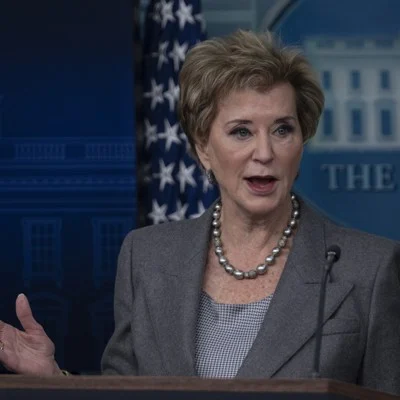Trump admin acknowledges difficulties in transferring Education programs to other agencies, internal documents show

The Education Department is raising internal concerns about its ability to offload its work to other agencies, documents prepared as part of the transfer process show, demonstrating potential speedbumps as the Trump administration looks to eliminate the agency altogether.
Shedding core programs to the Labor Department and other agencies throughout government will create significant logistical hurdles, Education said in an after-action report—obtained by Government Executive—on its trial initiative to jettison one of its smaller offices earlier this year. While the administration has trumpeted its success in previously moving the Office of Career, Technical, and Adult Education to Labor, it suggested the upcoming effort would be a far greater lift.
In addition to Labor, Education announced this week it will launch interagency agreements for programs to be primarily run by the departments of Health and Human Services, Interior and State.
“The size and scope of OCTAE’s programs are miniscule [sic] compared to other [Education Principal Operating Components] and programs,” the department wrote in its report. “Larger formula grants and competitive grants are going to be much more difficult to migrate.”
Education cited Elementary and Secondary Education and Postsecondary Education programs as examples. Such future transfers are going to be “more opaque” because they involve moving only parts of programs instead of programs in their entirety and, in some cases, will be split up between various receiving agencies.
The department told employees this week it would be detailing many of them to the agencies absorbing most of their work. In its report, Education stressed the importance of involving career leadership in the planning process for the transfer of work to “establish buy-in from rank-and-file staff to achieve a strong proportion of volunteers for the staff details.”
According to Education employees, however, that effort has yet to begin. Department leaders held a meeting with some impacted staff on Wednesday, but, according to one employee, shared “little-to-no answers for staff on logistics on how this will work and when.”
That resulted in “leaving staff with lots of anxiety and a sense that the admin is clueless,” the worker added. Leadership repeatedly stressed that the phasing out of the department would create professional opportunities for staff, which those in the meeting took as a failure to “read the room.”
Education should seek to provide “creature comforts” to employees to help ease the transition, according to its report, such as ensuring they have parking spots at their new locations.
“Career staff will see how much we care through our actions in ensuring their personal needs are met during the transition,” the report stated.
Education Secretary Linda McMahon has heralded her efforts as a way to cut through the bureaucracy and “return education to the states.” An employee briefed on initial plans for the transition disputed that argument, however, suggesting it would not make anything easier for Education’s grant recipients. Labor’s grant management systems, for example, have much more limited functionality than Education’s custom-built platforms, the individual said.
“This is a big step backwards in oversight capabilities,” the employee said.
For the programs transferring to Labor, only new grant awards will be part of the shift. That will require employees to maintain access to Education in addition to gaining access to their new place of work. In its report, Education called for work to begin immediately on “rebuilding the grants” at receiving agencies.
The department argued it was creating efficiency by providing states a single point of contact for various grants, rather than having similar programs split between two agencies. It noted Labor is rebranding its Employment and Training Administration to be the One Big Beautiful Talent Agency.
“Care must be taken to create the narrative that we are eliminating points of slippage and friction that result from similar programs being administered across multiple federal agencies, which causes states to replicate duplicative administrative state agency postures to engender support from the field,” Education said in its report.
The department noted, however, its earlier agreement with Labor, which transferred OCTAE responsibilities, was aided by preexisting relationships in the relevant offices.
“Future transfers may be supported by less defined relationships between receiving and requesting agency political staff,” Education said.
The report suggested Education has not landed on its statutory authority for making the changes. The unobligated funds to transfer over and the authority for doing so “must be identified before the transition begins,” it said in the report.
Even the relatively small OCTAE transition, Education said, nearly ran into issues because it almost missed a deadline to close out the work by the end of the fiscal year. Doing so would have been a “disaster,” it said, because funding streams would have been disrupted.




